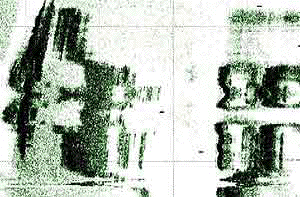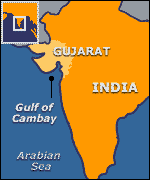|
|
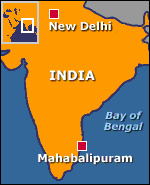 BBC Online |
|
This confirmation by the Archæological Survey of India, of the existence of the structures first referred to by Graham Hancock in his February/March 2002 UK TV documentary programmes “Flooded Kingdoms of the Ice Age”, which accompanied the release of his latest book “Underworld”, is heartening to all who believe that there is much more down there to find. Perhaps now marine archæologists will begin o re-focus away from old wrecks, and look more closely at the multitude of strange shapes covered in undersea plantlife on the coastal plains all over the world
…
“New finds worldwide support ‘Flood Myths’“
On May 28 2002 the
National Geographic News reported on the many recent discoveries underwater on the coastal shelves around the world. We could not improve on their ntroduction, which led with:
“Ancient stories of massive floods pass from generation to generation and in many places in the world are integral to a people’s spoken history. The tales differ by locale, but commonly feature either torrential rains or a hugely destructive wall of water bursting into a valley, destroying in its path. In many cases, the flooding is an act of retribution by displeased gods.
Scientists, historians, and archaeologists view many of these enduring tales as myth, legend, or allegoric tales meant to illustrate moral principles. Recent findings indicate that at least a few of them could be based on real floods that caused destruction on an enormous scale.”
Firstly they looked at the recent discovery of megalithic ruins some 2,200 ft below sea level, off the coast of Cuba. Interviewing geologist, Manuel turralde, the director of research at Cuba’s Natural History Museum, who stressed the need for an open mind while investigations of the site continue, National Geographic reported that the Canadian exploration company that discovered the formations, Advanced Digital Communications (ADC), has suggested that they could be the buildings and monuments of an early, unknown American civilization. Iturralde told them:
Paulina Zelitsky, the Polish-Canadian projects director of ADC, and her crew are believed to be currently aboard their research vessel, “Ulises”, on another expedition in the deep waters of Cabo de San Antonio, off the coast of Cuba’s Guanahacabibes Peninsula, where they reported late last year that they had found unusual formations of smooth blocks, crests, and geometric shapes. Her husband and partner in ADC, Dr Paul Weinzweig, told the
Canadian Globe & Mail last December that some of the structures within the complex may be as long as 400 metres wide and as high as 40 metres.
Some of the stills taken from the first video footage gathered by their R.O.V. (Remotely-Operated-Vehicle) had clearly shown “symbols and inscriptions”, though at that time they could not say for certain which language they were written in. Perhaps this summer’s expedition might shed some more light on this exciting aspect of their discovery. Data thus far has been collected using sidescan sonar and video, and collecting samples from the granite blocks and the sediment in which they are imbedded is the next step, reported National Geographic. Some researchers say that the discovery could completely alter the currently held views about the origins of ancient North American civilisation.
Next National Geographic News took a look at the recent underwater temples discovered offshore at Mahabulipuram, Tamil Nadu, in southeast India. Local legends tell that the area once had seven magnificent temples, but that six of these were swallowed by the sea. The seventh, and only remaining temple, still stands on the shore. Passed from generation to generation, the local folklore tells of a beautiful city that was destroyed by the gods because they were jealous of its beauty, so sent a flood to submerge it beneath the sea.
dry land discoveries news archive |
underwater discoveries news archive
“Underwater Japanese Pyramid ‘Manmade’ say Scientists”
On May 9 2002 a report on Whitley Strieber’s Unknown Country brought news that Frank Joseph, editor of “Ancient American Magazine”, would speak that night on “Dreamland” about a conference he recently attended in Japan at which Japanese geologists and archæologists argued that the sunken pyramid off the island of Yonaguni near Okinawa has been found to be manmade. It reported that:
“The structure was found by dive tour operator Kihachiro Aratake in 1985 and has been a source of controversy ever since. It appears to be a construction made of wide terraces, ramps and large steps. However, American geologists have contended that the structure is not manmade, but a natural formation.
According to the report, Japanese scientists have documented marks on the stones that indicate that they were hewn. Not only that, the tools used in this process have been found in the area, and carvings have been discovered. A small stairway carved into the rocks appears to render the theory that this is a natural formation implausible.”
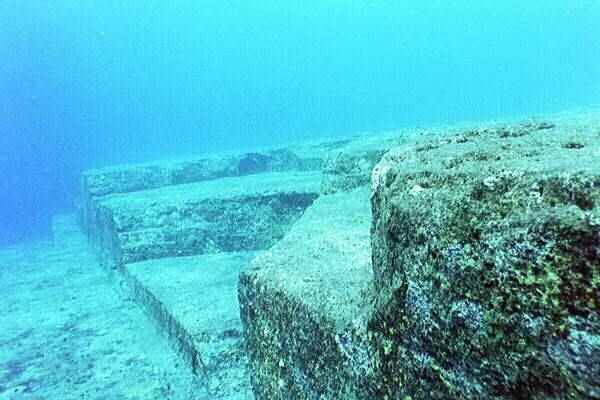 Copyright 1999 Dr. Robert M. Schoch. |
The story went on to report that the enigmatic underwater structure that was discovered by dive tour operator, Kihachiro Aratake, in 1985, has shown more evidence of being man-made.
|
Dr Schoch has made it clear that he feels the structure was (like the Great Sphinx of Egypt?) primarily a natural structure that people in ancient times carved or enhanced to suit their purposes. His comments in 1999 were:
“We should also consider the possibility that the Yonaguni Monument is fundamentally a natural structure that was utilized, enhanced, and modified by humans in ancient times.”
This type of activity seems to have been widely used in ancient times all over the archaic world, and has become known as ‘terra-forming’. Nature suggests a shape, and human hands go to work it to modify it as they want or need it to look. This could have been done for ritual purposes, or for purely practical ones. No-one is yet sure.
According to the report of the conference in Japan, there have been a number of discoveries recently that add a great deal of weight to the theory that the structure was certainly ‘terra-formed’ at least by ancient people:
“Japanese scientists have documented marks on the stones that indicate that they were hewn. Not only that, the tools used in this process have been found in the area, and carvings have been discovered. A small stairway carved into the rocks appears to render the theory that this is a natural formation implausible.
The problem with all of this for western scientists is that it implies that an unknown eastern culture had developed a high degree of organization thousands of years before the earliest western civilizations. Geologically, the Yonaguni pyramid sank into the ocean at the end of the last ice age, around ten thousand years ago. Some western geologists have theorized that, if it is manmade, it must have risen from the sea in more recent times, and been carved then.
However, the discovery of other, similar structures beneath the sea of Japan was also announced at the conference. If these prove to be similar to the Yonaguni pyramid they may rewrite the history of early man.”
Studies of the structure, such as that by Masaaki Kimura, a professor in the Department of Physics and Earth Sciences at the University of the Ryukyus, were responsible for initiating the debate that currently rages about Yonaguni. In September 1997 Dr Schoch dived on the structure for the first time. He had been invited there by Graham Hancock, who was then researching
“Heaven’s Mirror”, filming for a series of TV programmes, and laying the groundwork for his most recent book “Underworld”.
 Dr Schoch and Prof. Kimura on Yonaguni Island 1999 |
|
No doubt we will be hearing a lot more from the Yonaguni area in the near future, as structures have been recently discovered underwater of other Japanese islands such as Aguni and Kerama, and we are reliably informed that walls, and possible ancient roads have been discovered in the Straits of Taiwan, about 20ft to 30ft underwater between the island of Taiwan and mainland China. Watch this space …
dry land discoveries news archive |
underwater discoveries news archive
Another ‘Lost Underwater City’ found off the coast of India
Another ‘lost city’ has been discovered by divers off the coast of India.
BBC News Online on Thursday, April 11th, 2002, reported a story that divers from an Anglo-Indian exploration team had discovered, a ‘lost city’ only 15 to 21 feet underwater about half a mile offshore near Mammalapuram (Mahabalipuram) in Tamil Nadu, southeast India. It was found by a joint team from the Dorset, England, based organisation, the Scientific Exploration Society, and marine archæologists from the Indian National Institute of Oceanography. The story was covered by the BBC News,
The Guardian, and the UK Daily Telegraph, which reported that the expedition team discovered huge granite blocks and walls 20 feet below the surface. The expedition leaders referred to the ‘myth of Mahabalipuram’, which spoke of an ancient city that was ‘so beautiful that the gods became jealous and sent a flood that swallowed it up entirely in a single day’.
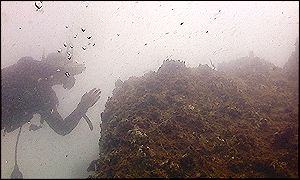 Copyright 2002 BBC Online |
On their website, BBC Online reported that the myths were first set down in writing by an eighteenth century British traveller, J. Goldingham, who visited the coastal Indian town in 1798 when it was known to sailors as the Seven Pagodas.
|
The ruins cover many square miles, and the BBC TV News showed images of a reconstruction of the mass of submerged buildings that the Anglo-Indian team have discovered. BBC Television News showed some interesting underwater footage of a strange ‘U-shaped’ structure that was reminiscent of the ‘horseshoe-shaped’ stones at Stonehenge. They were found during dives on April 1st 2002, though no-one yet is suggesting the date has any significance, and announced that another expedition is planned for 2003. The expedition leader, Monty Halls, told the BBC News Online:
“Our divers were presented with a series of structures that clearly showed man-made attributes. The scale of the site appears to be extremely extensive, with 50 dives conducted over a three-day period covering only a small area of the overall ruin field. This is plainly a discovery of international significance that demands further exploration and detailed investigation.”
 Copyright 2002 BBC Online |
The joint expedition team also included author and explorer, Graham Hancock, who had approached SES after diving off the coast of India in 2001, and gathering the myths and legends of the area regarding the ‘sunken city’. The expedition team has put up a new website just dealing with this discovery at http://www.india-atlantis.org/, and Hancock told the BBC:
|
This discovery featured in the recent (February/March 2002) UK Channel 4 television programmes, “Flooded Kingdoms of the Ice Age”, which accompanied the publication of Graham Hancock’s recent (February 2002) book “Underworld”, both of which contained new underwater footage of the enigmatic Yonaguni monument that was found almost 15 years ago off the coast of Yonaguni-Jima, Japan. They also contain unique underwater photographs of the structures found last year off the northwestern and southeastern coasts of India, at Khambhat (Cambay), and the new Indian discovery announced in April 2002 off the coast of Mammalapuram (Mahabalipuram) in Tamil Nadu, southeast India.
As the interest in ‘sunken cities’ and ‘submerged civilisations’ around the world continues to grow, the ‘History Channel’ has released VHS copies of its February 2002 television programme, “Japan’s Mysterious Pyramids”, which has some very interesting, and unique, underwater footage of this structure that is puzzling archæologists and geologists alike.
It seems that the Indian National Institute of Oceanography (NIO) has released information about the discovery at Mammalapuram (Mahabalipuram) and not mentioned the part Graham Hancock played in putting them together with S.E.S. The Indian Audarya Fellowship Forum has some interesting comments about the discovery and the NIO, including comments from Hancock about his disappointment with the ‘snub’. Hancock’s own reactions to the news story are here
…
There is an interesting report of the discovery on the
Ananova website, with an interesting underwater picture we’ve not seen before. While there was coverage of this story in The Independent, which highlights the ‘1500 year’ date proposed by some archæologists, and also an interesting article in The Times of London.
dry land discoveries news archive |
underwater discoveries news archive
“Lost Underwater City ‘could rewrite
history’“
That was headline at BBC News Online on Saturday, January 19, 2002. Written by Tom Housden, it told of a ‘lost city’ discovered 120 feet underwater in the Gulf of Khambhat (Cambay) off the western coast of Gujarat, in India. It was found completely by chance by marine scientists from the Indian National Institute of Ocean Technology, (NIOT), who were conducting a water pollution survey of the area. Oceanographers from NIOT told the BBC that they had discovered archæological remains 120 feet underwater in the Gulf of Khambhat (Cambay) which could be over 9,000 years old.
Indian marine archæologists used a technique called “sub-bottom profiling” to show that the remains of the many buildings of this vast city, which is five miles long and two miles wide, and said to predate the oldest known archæological remains on the Indian subcontinent by more than 5,000 years, stand on enormous foundations. Naturally, the BBC went to interview Graham Hancock, who, despite the obvious dangers involved, has regularly dived on ancient structures in many parts of the world in pursuit of his belief that there is “a big missing chapter in man’s early history”.
This is a belief which is increasingly being shared by many, including some archæologists, who are reluctantly having to come to terms with the fact that there is quite likely to be much more evidence of ancient civilisation waiting to be discovered at the bottom of the oceans, on continental shelves, and in areas of shallow seas, all over the world. In fact, lying underwater in the Gulf of Khambhat (Cambay), there are not one, but two massive cities, both around the size of Manhattan, one approximately 8 km long and the other some 9km in length.
As we enter the 21st century, advances in computer technology are allowing Oceanographers everywhere to use sophisticated computer programs in order to simulate the ancient sea-levels before the end of the last Ice Age. As a result, they are discovering huge tracts of land all around the world that were above water some 10 to 15,000 years ago. While this would have been obvious to marine scientists for a many, many years, marine archæologists have tended to restrict their underwater activities to the recovery of ‘sunken treasure’ and have barely, if ever, considered the possibility that ‘any’ evidence of ancient civilisation from before the end of the last Ice Age could be found in exactly the locations they have been discovered over the past decade or so.
Hancock told
BBC Online:
“The [oceanographers] found that they were dealing with two large blocks of apparently man-made structures. Cities on this scale are not known in the archæological record until roughly 4,500 years ago when the first big cities began to appear in Mesopotamia. Nothing else on the scale of the underwater cities of Cambay is known. The first cities of the historical period are as far away from these cities as we are today from the pyramids of Egypt.”
Recent discoveries such as that of the Yonaguni monument in the East China sea between Japan and Taiwan, and more recently of a ‘Lost
City’ in the Caribbean Sea, between the Yucatan Peninsula of Mexico and the western coast of the Guanahacabibes Peninsula of Cuba, are adding to the sense of awe that many of those involved in the historical sciences generally are beginning to feel as their long-cherished prehistory paradigms are being completely trashed again and again. Hancock told BBC Online:
“There’s a huge chronological problem in this discovery. It means that the whole model of the origins of civilisation with which archæologists have been working will have to be remade from scratch.”
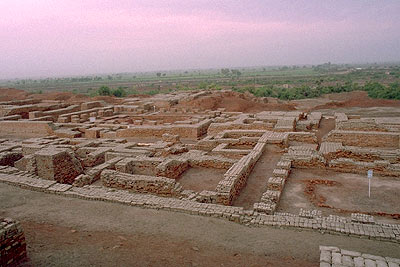
|
But, not everyone agrees at all with Hancock’s argument, preferring to link the discoveries with the Harappan period. BBC Online also interviewed an archæologist from the British Museum, Dr Justin Morris, who told them that a lot more work would need to be undertaken before the site could be categorically said to belong to a 9,000 year old civilisation. Justin Morris told BBC Online:
|
Dr Morris further told BBC Online that artifacts recovered from the sites of these two massive prehistoric urban settlements would need to be very carefully analysed, and, as the BBC reported, Dr Morris: ” … pointed out that the C14 carbon dating process is not without its error margins.”
True, but this sounds very much like the usual ‘sour grapes’ with which the archæological community has responded to the work which Graham Hancock, and his wife, the photographer Santha Faiia, have painstakingly conducted over the last 5 to 10 years. Unable to accept that they are simply wrong in many respects about prehistory, many academics have stooped to the sort of tactics that were highlighted in the now infamous BBC Horizon-Atlantis affair, concerning two programmes about Atlantis which were broadcast in October and November 1999.
The tactics used there were (a) to examine the not so well-known fact that elements of the German Nazi Party under Adolf Hitler were facinated by the idea of Atlantis, and then (b) to attempt to portray Hancock, and all others interested in Atlantis and the possibility that there may be thousands of ancient cities at the bottom of our oceans, as somehow heading for “a slippery slope” down into the sewer of Nazi ideology. Entitled “Atlantis Uncovered”, and “Atlantis Reborn”, the programmes should have been more correctly called “Get Hancock”.
But these are far from the tactics adopted by the BBC Online team, who have treated Hancock with similar respect to that which they treat their own underwater camera operaters, seeming to appreciate the very real dangers of embarking on underwater discovery expeditions of any sort. Acknowledging both Hancock’s logic, and the constant dangers he has faced in his quest for “a big missing chapter in man’s early history”, they reported that:
“It is believed that the area was submerged as ice caps melted at the end of the last ice age 9 – 10,000 years ago.”
BBC Online went on to report that although the first signs of a significant archæological find came eight months ago, exploring the area has been extremely difficult because of the “highly treacherous waters, with strong currents and rip tides”. It seems now that with the recent recovery from the sea floor in the Gulf of Khambhat (Cambay) of carbon datable artifacts, including pieces of ancient timber, the Indian government has set up a special team to oversee further studies in this area. The Indian Minister for Human Resources and ocean development, Murli Manohar Joshi, who seems convinced by the discoveries of marine scientists from his own National Institute of Ocean Technology, told them:
“We have to find out what happenned then … where and how this civilisation vanished.”
That there will inevitably be much evidence of Ice Age civilisation discovered on the vast tracts of land submerged after the end of the last Ice Age is something that Morien Institute researchers have been saying for many years, and it hadn’t gone unnoticed that their January 2002 story was not first time that BBC Online has referred to the discovery of these incredible archæological remains in this eastern part of the Arabian Sea.
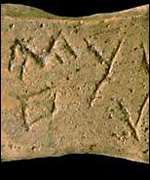 Copyright 2002 BBC Online |
|
Since May 2001, those in charge of the Indian marine archæological research project in the Gulf of Khambhat (Cambay) have come increasingly to believe that the remains are very definitely pre-Harappan, and Graham Hancock has dived in the company of some of their leading marine archaeologists in many areas around the coasts of India. Sceptics, both academic and otherwise, and especially those who missed the recent (February/March 2002) programmes on UK Channel 4, “Flooded Kingdoms of the Ice Age”, should read Hancock’s recent (February 2002) book “Underworld”, before they go pronouncing any further about the ‘impossibility’ of any remains of Ice Age civilisations being discovered offshore. They already have been – in Japan and in India in depths of up to 300 feet underwater, and also in Cuba, where the remains of a vast city have, amazingly, been found some 2,200 feet underwater.
There’s no glory in stiffling debate about prehistory, and there’s equally no shame in being wrong about the chronology of human civilisation. Perhaps the time has come for our academics to admit their errors, as Hancock
has done recently on UK Channel 4, and to an audience the size of which most of them can only dream about. Both are looking for clues about the origin of civilisation, and to his credit, Graham Hancock, for his part at least, is prepared to admit:
“In doing so I’ve occasionally followed highly speculative leads, some of which I now realize have led me wide of the mark. This has attracted a lot of criticism, some of it richly deserved. But none of it’s convinced me that there couldn’t be a big missing chapter in man’s early history.”
dry land discoveries news archive |
underwater discoveries news archive
2004 archive |
2003 archive |
2001 archive |
2000 archive
see ‘unique underwater footage’ of the Yonaguni monument
the VHS video of the ‘History Channel’ November 2002 television programme
please take a look at our Ancient Mysteries Bookshoppe for a wide selection of books
that challenge orthodox views of prehistory on every continent
home |
research projects |
skywatching |
news & new discoveries |
marketspace |
contact us
all material on this page
morien institute
morien-institute.org 1996-2004


